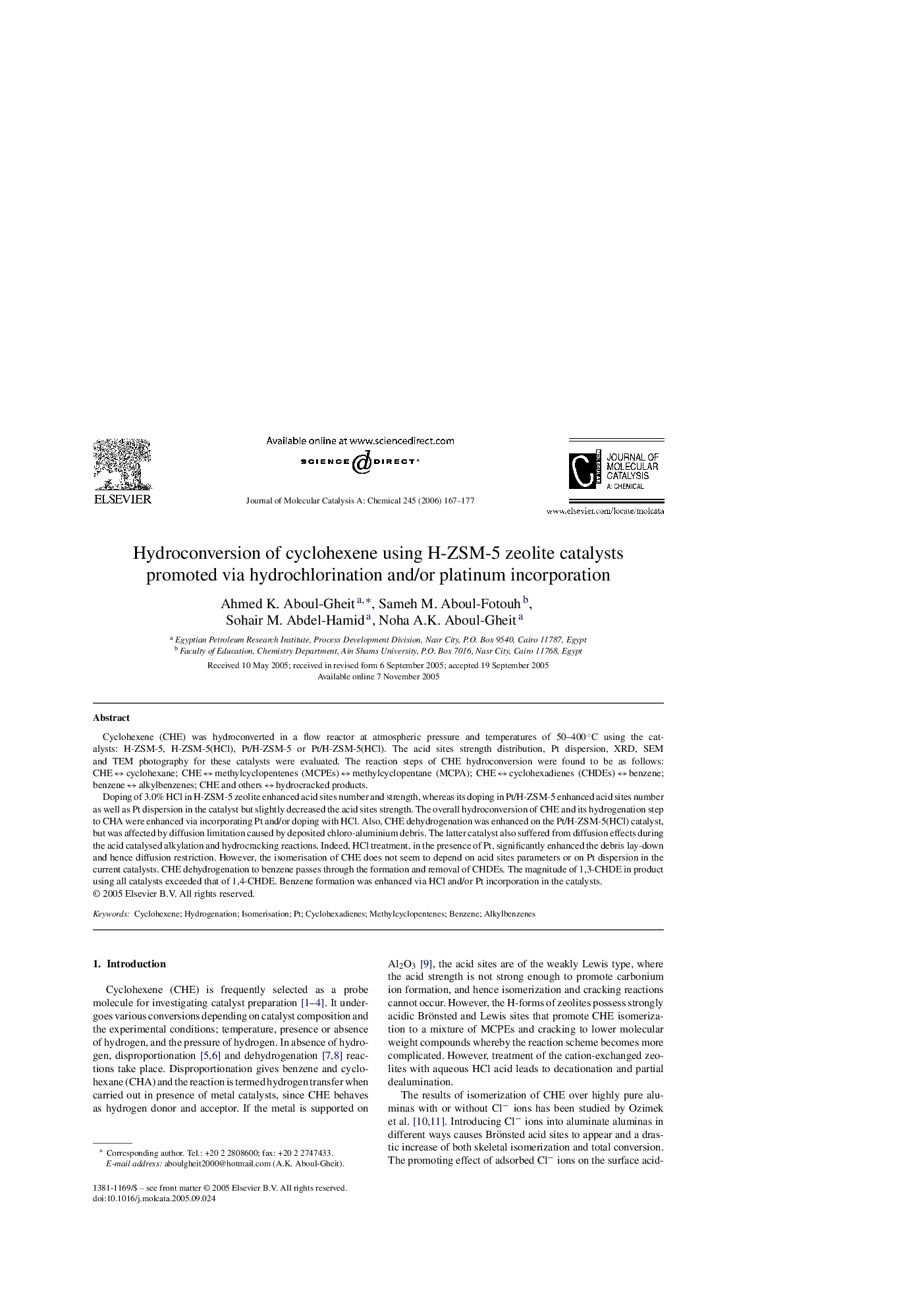| کد مقاله | کد نشریه | سال انتشار | مقاله انگلیسی | نسخه تمام متن |
|---|---|---|---|---|
| 69149 | 48531 | 2006 | 11 صفحه PDF | دانلود رایگان |

Cyclohexene (CHE) was hydroconverted in a flow reactor at atmospheric pressure and temperatures of 50–400 °C using the catalysts: H-ZSM-5, H-ZSM-5(HCl), Pt/H-ZSM-5 or Pt/H-ZSM-5(HCl). The acid sites strength distribution, Pt dispersion, XRD, SEM and TEM photography for these catalysts were evaluated. The reaction steps of CHE hydroconversion were found to be as follows: CHE ↔ cyclohexane; CHE ↔ methylcyclopentenes (MCPEs) ↔ methylcyclopentane (MCPA); CHE ↔ cyclohexadienes (CHDEs) ↔ benzene; benzene ↔ alkylbenzenes; CHE and others ↔ hydrocracked products.Doping of 3.0% HCl in H-ZSM-5 zeolite enhanced acid sites number and strength, whereas its doping in Pt/H-ZSM-5 enhanced acid sites number as well as Pt dispersion in the catalyst but slightly decreased the acid sites strength. The overall hydroconversion of CHE and its hydrogenation step to CHA were enhanced via incorporating Pt and/or doping with HCl. Also, CHE dehydrogenation was enhanced on the Pt/H-ZSM-5(HCl) catalyst, but was affected by diffusion limitation caused by deposited chloro-aluminium debris. The latter catalyst also suffered from diffusion effects during the acid catalysed alkylation and hydrocracking reactions. Indeed, HCl treatment, in the presence of Pt, significantly enhanced the debris lay-down and hence diffusion restriction. However, the isomerisation of CHE does not seem to depend on acid sites parameters or on Pt dispersion in the current catalysts. CHE dehydrogenation to benzene passes through the formation and removal of CHDEs. The magnitude of 1,3-CHDE in product using all catalysts exceeded that of 1,4-CHDE. Benzene formation was enhanced via HCl and/or Pt incorporation in the catalysts.
Cyclohexene (CHE) was hydroconverted in a flow reactor at atmospheric pressure and temperatures of 50–400 °C using the catalysts: H-ZSM-5, H-ZSM-5(HCl), Pt/H-ZSM-5 or Pt/H-ZSM-5(HCl). The acid sites strength distribution, Pt dispersion, XRD, SEM and TEM photography for these catalysts were evaluated. The reaction steps of CHE hydroconversion were found to be as follows: CHE ↔ cyclohexane; CHE ↔ methylcyclopentenes (MCPEs) ↔ methylcyclopentane (MCPA); CHE ↔ cyclohexadienes (CHDEs) ↔ benzene; benzene ↔ alkylbenzenes; CHE and others ↔ hydrocracked products.Doping of 3.0% HCl in H-ZSM-5 zeolite enhanced acid sites number and strength, whereas its doping in Pt/H-ZSM-5 enhanced acid sites number as well as Pt dispersion in the catalyst but slightly decreased the acid sites strength. The overall hydroconversion of CHE and its hydrogenation step to CHA were enhanced via incorporating Pt and/or doping with HCl. Also, CHE dehydrogenation was enhanced on the Pt/H-ZSM-5(HCl) catalyst, but was affected by diffusion limitation caused by deposited chloro-aluminium debris. The latter catalyst also suffered from diffusion effects during the acid catalysed alkylation and hydrocracking reactions. Indeed, HCl treatment, in the presence of Pt, significantly enhanced the debris lay-down and hence diffusion restriction. However, the isomerisation of CHE does not seem to depend on acid sites parameters or on Pt dispersion in the current catalysts. CHE dehydrogenation to benzene passes through the formation and removal of CHDEs. The magnitude of 1,3-CHDE in product using all catalysts exceeded that of 1,4-CHDE. Benzene formation was enhanced via HCl and/or Pt incorporation in the catalysts.
Journal: Journal of Molecular Catalysis A: Chemical - Volume 245, Issues 1–2, 15 February 2006, Pages 167–177